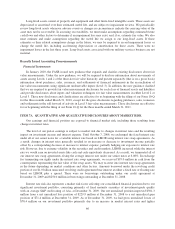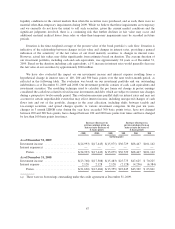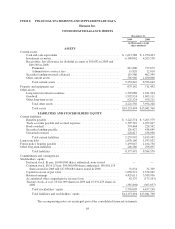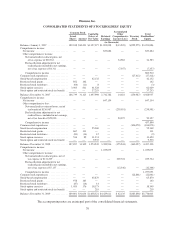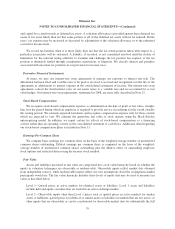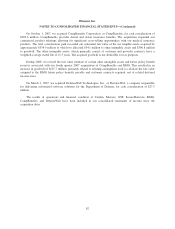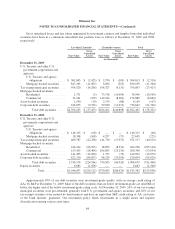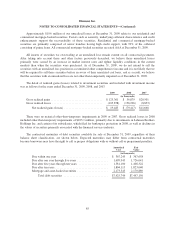Humana 2009 Annual Report Download - page 85
Download and view the complete annual report
Please find page 85 of the 2009 Humana annual report below. You can navigate through the pages in the report by either clicking on the pages listed below, or by using the keyword search tool below to find specific information within the annual report.Humana Inc.
NOTES TO CONSOLIDATED FINANCIAL STATEMENTS—(Continued)
providing this insurance coverage ratably over the term of our annual contract. Our CMS payment is subject to
risk sharing through the Medicare Part D risk corridor provisions. In addition, receipts for reinsurance and
low-income cost subsidies represent payments for prescription drug costs for which we are not at risk.
The risk corridor provisions compare costs targeted in our bids to actual prescription drug costs, limited to
actual costs that would have been incurred under the standard coverage as defined by CMS. Variances exceeding
certain thresholds may result in CMS making additional payments to us or require us to refund to CMS a portion
of the premiums we received. We estimate and recognize an adjustment to premium revenues related to these risk
corridor provisions based upon pharmacy claims experience to date as if the annual contract were to terminate at
the end of the reporting period. Accordingly, this estimate provides no consideration to future pharmacy claims
experience. We record a receivable or payable at the contract level and classify the amount as current or long-
term in the consolidated balance sheets based on the expected settlement.
Reinsurance and low-income cost subsidies represent funding from CMS in connection with the Medicare
Part D program for which we assume no risk. Reinsurance subsidies represent funding from CMS for its portion
of prescription drug costs which exceed the member’s out-of-pocket threshold, or the catastrophic coverage level.
Low-income cost subsidies represent funding from CMS for all or a portion of the deductible, the coinsurance
and co-payment amounts above the out-of-pocket threshold for low-income beneficiaries. Monthly prospective
payments from CMS for reinsurance and low-income cost subsidies are based on assumptions submitted with our
annual bid. A reconciliation and related settlement of CMS’s prospective subsidies against actual prescription
drug costs we paid is made after the end of the year. We account for these subsidies as a deposit in our
consolidated balance sheets and as a financing activity in our consolidated statements of cash flows. We do not
recognize premium revenues or benefit expense for these subsidies. Receipt and payment activity is accumulated
at the contract level and recorded in our consolidated balance sheets in other current assets or trade accounts
payable and accrued expenses depending on the contract balance at the end of the reporting period.
For plans where we provide enhanced benefits and selected the alternative demonstration payment option in
lieu of the reinsurance subsidy, we receive a monthly per member capitation amount from CMS determined from
our annual bid submissions. The capitation amount we receive from CMS for assuming the government’s portion
of prescription drug costs in the catastrophic layer of coverage is recorded as premium revenue. The variance
between the capitation amount and actual drug costs in the catastrophic layer is subject to risk sharing as part of
the risk corridor settlement. See Note 6 for detail regarding amounts recorded to the consolidated balance sheets
related to the risk corridor settlement and subsidies from CMS.
Settlement of the reinsurance and low-income cost subsidies as well as the risk corridor payment is based on
a reconciliation made approximately 9 months after the close of each calendar year. We continue to revise our
estimates with respect to the risk corridor provisions based on subsequent period pharmacy claims data.
Military services
Military services revenue primarily is derived from our TRICARE South Region contract with the
Department of Defense, or DoD. We allocate the consideration to the various components of the contract based
on the relative fair value of the components. TRICARE revenues consist generally of (1) an insurance premium
for assuming underwriting risk for the cost of civilian health care services delivered to eligible beneficiaries;
(2) health care services provided to beneficiaries which are in turn reimbursed by the federal government; and
(3) administrative services fees related to claim processing, customer service, enrollment, disease management
and other services. We recognize the insurance premium as revenue ratably over the period coverage is provided.
Health care services reimbursements are recognized as revenue in the period health services are provided.
75



